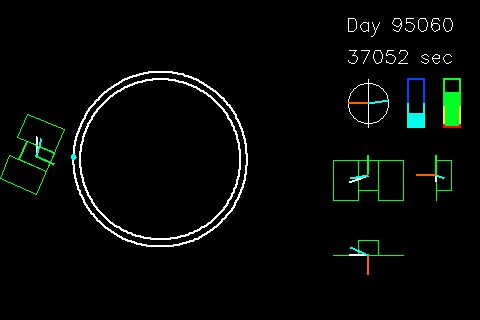
Click on the above still image to go to a page identical to this one but with the animated GIF movie in place of the still. The movie is about 3.4 MB in size; if you would prefer to save it to disk separately, you can use your browser's capabilities and this link to download it directly and skip loading it into your browser.
This is a dawn-dusk orbit that traverses the South Atlantic Anomaly region near the ascending node; the spacecraft pointing strategy is "j-perp", with the ram avoidance constraint in effect. At the start of the orbit, the spacecraft is in the SAA, pointing the instruments perpendicular to the field; actually, it's still settling down from a 180° flip performed as it crossed the equator. At 37430 seconds UT, the local model field magnitude rises above 0.3 Gauss, and the spacecraft swings the instruments to point antiparallel to the projection of the field into the sun-normal plane. It overshoots and then holds attitude to let the field rotation (in the spacecraft frame) "catch up", resulting in a period of "pseudo-coast-mode" from 37688 to 37784 sec (this is typical of the "floor" we have noticed in the amount of time in coast mode identified by my algorithms). Next the ram-avoidance constraint is encountered from about 39032 sec until the field magnitude drops below 0.3 Gauss at 39788 sec. The instruments are turned perpendicular to the field, then the spacecraft starts to flip 180° as it crosses the equator, but this is interrupted as the field magnitude again rises above 0.3 Gauss at 39896 sec (this is at the longitude opposite the SAA, so the weak-field region is narrow). The ram constraint is again encountered from about 41480 sec until the weak-field region is reentered at 41984 sec. The instruments are turned perpendicular to the magnetic field, and another 180° flip begins at 42656 sec.
This orbit illustrates the reason for the minimum amount of "coast mode" that my algorithms identified, even during full-sun orbits, under this pointing strategy; there was no true coast mode at all. Also, this illustrates the 180° flips that occur when the spacecraft crosses the equator in the low-field regions.
 To
next movie (orbit 14466)
To
next movie (orbit 14466) Back
to top of Attitude Movies
Back
to top of Attitude Movies Back
to top of Data Pages
Back
to top of Data Pagesnew 9 March 1999